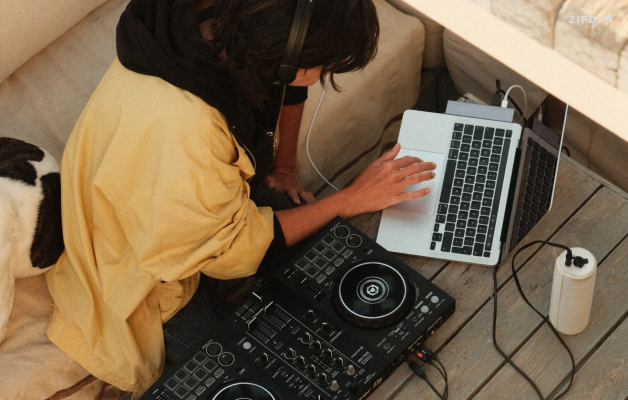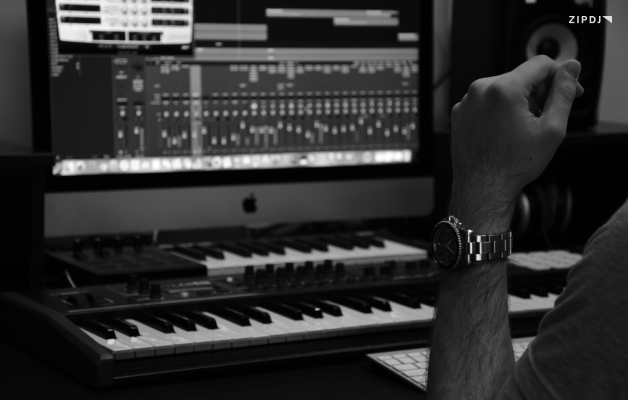The Art of Remixing: An In-Depth Guide Into The Creative Process

From understanding how to construct beats to mastering samples, the art of remixing encapsulates the core processes of music production.
Remixes are also invaluable resources for DJs who want variation in their playlists and extended versions to use while mixing.
Whether you’re a DJ or an aspiring producer, this in-depth guide to the creative process of remixing will give you plenty of inspiration.
The Art of Remixing: An In-Depth Guide Into The Creative Process For 2024
A good remix is characterized by a variety of elements, retaining the spirit of the original version while allowing the producer to add their own stamp.
If you’re a DJ looking to build a collection of remixes or considering producing your own versions, this guide has got you covered.
So, let’s explore the art of remixing and how it can help you develop your DJing skills and introduce you to music production in 2024:
Understanding The Culture Of Remixes
Remix culture is deeply embedded in the history of electronic music and its evolution and refinement over the past few decades.
They have helped to define well-established genres, as well as forging new paths and helping create new and unique subgenres.
The first thing you should do if you’re learning how to remix a song is dedicate time to researching how the concept of remixing has evolved.
Some remix artists retain the essence of the original song and stick to the relevant genre, while others take an altogether different style.
With an insane amount of remixes on the market, there’s no shortage of established and creative work to give you new ideas.
Before you start making music, dig up remixes produced by some of your favorite artists and see how they manipulate sounds from the original artist.
The more references you gather, the better your gauge will become when discerning what makes a bad remix and how a great remix should sound.
Make a mental note of how the original elements are retained while also separating the individual parts the remixer has introduced.
With remix albums representing a solid business move from artists such as Madonna, it’s an art form well worth adding to your repertoire.
Learning The Remix Process
If you’re ready to sit down and work on your first remix, you need to have a firm grasp of the types of remixes and the work involved.
The type of remix you opt for will make a difference in how you approach the production and the original elements that work best.
Club remixes typically extend the original song and add intros and outros which are dominated by the kick drum and percussion.
This gives club DJs room to blend tracks in and out of one another without having to worry about clashing harmonies and vocals.
Radio edits are much shorter versions that typically run for around three minutes, and can also involve removing curse words from lyrics.
The process of remixing begins with deconstructing the original work to isolate elements such as vocals, drums, and instrumentals.
The remixer then brings their musical inspiration to the table and rethinks how these core elements can be adapted to their version.
Additional instruments, percussive elements, vocals, and samples are all included in layers along with original elements that have been retained.
Finally, the remixed version is mixed and mastered to add compression and fine-tune the EQing for a professional and polished sound.
Respecting Copyright Laws
Copyright laws exist worldwide, and are designed to protect artists from having their work copied in whole or part without their permission.
When remixing a song, you’ll inevitably be working with other artist’s music, so an understanding of the legal framework is essential.
It may be that you’re able to use tracks under Creative Commons licenses or work directly with an artist or record label.
If you have contacts with someone at a record company through your DJing, they may be able to help you submit a remix example.
Artists of all sizes have experienced repercussions for violating these laws, with Dua Lipa as one example of a star facing a lawsuit.
When you’re developing remix production skills, you can remix whatever tracks you please, provided you don’t release them commercially.
It’s also worth being aware of how you can use samples from the original version and use these without violating copyright laws.
Provided you’ve significantly altered the sample so it’s distinguishable from the original, it can be classed as a new, creative work.
Researching Great Remixes
A great DJ is someone who understands their role as a curator of music, with a deep appreciation for and knowledge of music production.
Taste in music is entirely subjective, so what constitutes a great remix is, at least in part, determined by your music preferences.
This perspective provides a good starting point for listening to great remixes that approach the process in alignment with your tastes.
If you’re into harder music for the dance floor, the best techno DJs have produced many remixes throughout their careers.
For a more general approach to remixes, you can search for all-time lists of outstanding remixes that may be from a broader list of genres.
As you listen to each remix, try to identify the various elements from the original and new versions to see how the production has been assembled.
Over time, you’ll develop a deepening insight into the process of remixing and plenty of ideas for how to perform this yourself.
Learning From Bad Remixes
Musicians learn through their mistakes, and the same is true for remixers when it comes to understanding what works and what doesn’t.
Just as learning from mistakes is a crucial part of learning DJ performance tips, so too can remix producers learn from the bad examples.
Bad remixing covers several music production processes, as well as a failure to bring something new and refreshing to the table.
Sometimes, remixes are produced quickly to meet release schedules, making them rushed and inferior listening experiences.
Other bad remixes fail to respect the vibe of the original artists, muddying otherwise crisp vocals and generally mismanaging the track.
Each bad remix you listen to will have its particular flaws and will help you craft musical ideas that avoid these mistakes.
It will also give you a grasp of what types of songs don’t work when it comes to remixing and help choose the best project.
Selecting The Appropriate Tools
If you’re diving into music production and want to start with remixes, the tools required are essentially the same ones.
One of the first steps of becoming a DJ producer is to choose a digital audio workstation (DAW) to arrange and edit your remixes.
Platforms such as Ableton Live and Logic Pro are commonly used by professional music producers to sequence and introduce samples.
Alternatives such as FL Studio deliver more affordable alternatives that come loaded with effects and channels for samples and MIDI tracks.
If you’re familiar with using stems through your DJ software, this will give you an advantage when breaking down your remix elements.
These can be loaded into your DAW and edited down to smaller samples and added into the mix as discreet, manipulated elements.
If you’re adding your compositions for instruments and synths, consider investing in a MIDI keyboard to avoid using the mouse.
This will make the process much more fun and engaging, as well as develop a core skill most music producers learn.
Deconstructing The Original Song
Once you’ve established your home studio setup and learned how to make beats, you’re ready to get to work on a remix.
The first thing you’ll do is take the song you’re remixing and break it down into a variety of elements to use in your remix.
The drums and percussion, as well as instrumentation, chord patterns, melodies, and vocals, are all elements you should deconstruct.
Next, you should break down the song’s structure and composition, including the chorus and verse as well as any fills and breakdowns.
As you separate each of these song elements from one another, consider how you can add your own stamp on the sounds.
If there’s a noise you think can be manipulated to create something new, add it to a folder and come back to it later.
Remixing is a great opportunity to master your DAW’s many tools, from introducing reverb or chorus effects to stretching sounds.
Use this process to play around with your tools and other plugins, as well as rearrange melodies on software synthesizers.
Mastering Vocals
Vocals are the lead element in many great songs and are integral to most types of remixes, regardless of the genre or style.
Just as mastering key and harmony are common pain points for DJs, so too is mastering vocals a challenge for remix producers.
Many of the greatest remix producers of all time will begin by separating the vocals and using them as their starting point.
The vocals dictate the hook and melody, holding the song together and informing the instrumental arrangement and percussion.
The singer’s intonation, timing, and verbal inflections are all aspects of a vocal performance you should analyze when working on remixes.
Vocals don’t have to be reproduced accurately for a remix to work and can be liberally chopped up and rearranged to great effect.
What works for one particular remix might be completely inappropriate for another, and your sense of judgment will refine over time.
As you master the art of remixing, your ability to get the most out of your vocals will improve along with new mixing and production techniques.
Developing An Ear For Hidden Elements
While the vocals typically sit on top of the track and dominate the waves, great music often features lots of discreet and hidden elements.
These subtle sounds can include anything from background ambient noises to precisely engineered hits that dominate a frequency.
As a remixer, your job is to develop a keen ear for picking out these hidden elements and using them when reconstructing a track.
At the same time, the advances in the use of artificial intelligence in music make it much easier to isolate these elements to use.
Some elements to bear in mind include the use of distorted vocal snippets that sit layered in the background percussion.
Ambient pads, interesting instruments, and spoken word elements are also great for helping you become inspired.
The more elements you can collect that have potential, the greater your degree of creativity will become when producing remixes.
Over time, you can build a comprehensive library archiving all types of samples to use when producing future remixes.
Downloading Sample Packs
The proliferation of sample packs in recent years has given established and up-and-coming music producers a wealth of resources.
Sample packs are available for all types of genres and subgenres, so there’s something for everyone to use when producing remixes.
You can choose a sample pack dedicated to drums, or invest in packs that cover a range of instruments, loops, and effects.
If you’ve learned how to make mashups, you’ll already have an idea of how samples are used to create new and original music.
You don’t have to spend a lot of money, with plenty of free sample pack options to get basic samples ready to use.
Paid sample packs are often available in sales, so it’s also worth checking back on suppliers to see if they have any discounts and offers.
Bear in mind, that a sample pack is a template for production, and you can create an endless variety of new sounds by manipulating samples.
As you break down the original version’s elements, you can also use these to create personalized sample packs for future projects.
Summary
Artists and producers have been collaborating for decades, and the art of remixing reflects how the process brings together different sensibilities.
It’s a great way to hone your understanding of track elements and improve DJ sets, as well as take the next step into DJ production.
With plenty of free and affordable music production tools to get started with, entering the world of remixing has never been easier.
Draw inspiration from the latest exclusive remixes with a ZIPDJ subscription and access an extensive archive of tracks.
Not a member ?
Join Today for Unlimited Music Downloads. Visit zipdj.com for more information.



